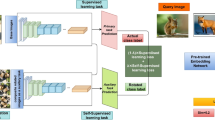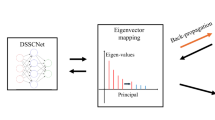Abstract
Multi-view data are popular in many machine learning and computer vision applications. For example, in computer vision fields, one object can be described with images, text or videos. Recently, multi-view subspace clustering approaches, which can make use of the complementary information among different views to improve the performance of clustering, have attracted much attention. In this paper, we propose a novel multi-view subspace clustering method with Kronecker-basis-representation-based tensor sparsity measure (MSC-KBR) to address multi-view subspace clustering problem. In the MSC-KBR model, we first construct a tensor based on the subspace representation matrices of different views, and, then the high-order correlations underlying different views can be explored. We also adopt a novel Kronecker-basis-representation-based tensor sparsity measure (KBR) to the constructed tensor to reduce the redundancy of the learned subspace representations and improve the accuracy of clustering. Different from the traditional unfolding-based tensor norm, KBR can encode both sparsity insights delivered by Tucker and CANDECOMP/PARAFAC decompositions for a general tensor. By using the augmented Lagrangian method, an efficient algorithm is presented to solve the optimization problem of the MSC-KBR model. The experimental results on some datasets show that the proposed MSC-KBR model outperforms many state-of-the-art multi-view clustering approaches.






Similar content being viewed by others
References
Berkhin, P.: A survey of clustering data mining techniques. In: Kogan J., Nicholas C., Teboulle M. (eds) Grouping Multidimensional Data. Springer, Berlin, Heidelberg. pp. 1–56 (2006). https://doi.org/10.1007/3-540-28349-8_2
Ng, A.Y., Jordan, M.I., Weiss, Y.: On spectral clustering: analysis and an algorithm. In: Proceedings of the Neural Information Processing Systems, pp. 849–856 (2002)
Elhamifar, E., Vidal, R.: Sparse subspace clustering: algorithm, theory, and applications. IEEE Trans. Pattern Anal. Mach. Intell. 35(11), 2765–2781 (2013)
Liu, G., Lin, Z., Yan, S., Sun, J., Yu, Y., Ma, Y.: Robust recovery of subspace structures by low-rank representation. IEEE Trans. Pattern Anal. Mach. Intell. 35, 171–184 (2013)
Zhao, C., Chen, K., Zang, D., Zhang, Z., Zuo, W., Miao, D.: Uncertainty-optimized deep learning model for small-scale person re-identication. Sci. China Inf. Sci. 62(12), 1–13 (2019). https://doi.org/10.1007/s11432-019-2675-3
Zhao, C., Wang, X., Miao, D., Xu, Y., Zhang, D.: Maximal granularity structure and generalized multi-view discriminant analysis for person re-identification. Pattern Recogn. 79, 79–96 (2018)
Gu, J., Li, P.: Multi-view feature selection for heterogeneous face recognition. In: IEEE International Conference on Data Mining (ICDM), pp. 983–988 (2018)
Zhang, C., Fu, H., Liu, S., Liu, G., Cao, X.: Low-rank tensor constrained multiview subspace clustering. In: IEEE International Conference on Computer Vision (ICCV), Santiago, Chile, pp. 1582–1590 (2015)
Xia, R., Pan, Y., Du, L., Yin, J.: Robust multi-view spectral clustering via low-rank and sparse decomposition. In: Proceedings of the Twenty-Eighth AAAI Conference on Artificial Intelligence, Québec City, Québec, Canada, pp. 2149–2155 (2014)
Xie, Y., Tao, D., Zhang, W., Liu, Y., Zhang, L., Qu, Y.: On unifying multi-view self-representations for clustering by tensor multi-tank minimization. Int. J. Comput. Vis. 126(11), 1157–1179 (2018)
Cao, X., Zhang, C., Fu, H., Liu, S., Zhang, H.: Diversity induced multi-view subspace clustering. In: IEEE Conference on Computer Vision and Pattern Recognition (CVPR), Boston, MA, USA, pp. 586–594 (2015)
Xu, C., Tao, D., Xu, C.: A survey on multi-view learning, pp. 1–59, arXiv:1304.5634v1 (2013)
Bickel, S., Scheffer, T.: Multi-view clustering. In: Proceedings of the Fourth IEEE International Conference on Data Mining (ICDM), Brighton, pp. 19–26 (2004)
Kumar, A., Rai, P., Hal Daumé, I.: Co-regularized multi-view spectral clustering. In: Proceedings of the 24th International Conference on Neural Information Processing Systems (NIPS), Granada, pp. 1413–1421 (2011)
Yin, Q., Wu, S., Wang, L.: Multiview clustering via unified and view-specific embeddings learning. IEEE Trans. Neural Netw. Learn. Syst. 29(11), 5541–5553 (2018)
Yin, M., Gao, J., Xie, S., Guo, Y.: Multiview subspace clustering via tensorial t-Product representation. IEEE Trans. Neural Netw. Learn. Syst. 30(3), 851–864 (2019)
Sa, V.R.D.: Spectral clustering with two views. In: ICML Workshop on Learning with Multiple Views, pp. 20–27 (2005)
Liu, J., Wang, C., Gao, J., Han, J.: Multi-view clustering via joint nonnegative matrix factorization. In: Proceedings of the 2013 SIAM International Conference on Data Mining, pp. 252–260 (2013)
Tzortzis, G., Likas, A.: Kernel-based weighted multi-view clustering. In: Proceedings of the IEEE International Conference on Date Mining, Brussels, pp. 675–684 (2012)
Vidal, R.: Subspace clustering. IEEE Signal Process. Mag. 28(2), 52–68 (2011)
Brbić, M., Kopriva, I.: Multi-view low-rank sparse subspace clustering. Pattern Recogn. 73, 247–258 (2018)
Gao, H., Nie, F., Li, X., Huang, H.: Multi-view subspace clustering. In: Proceedings of the IEEE International Conference on Computer Vision, pp. 4238–4246 (2015)
Yan, C., Gong, B., Wei, Y., Gao, Y.: Deep multi-view enhancement hashing for image retrieval. IEEE Trans. Pattern Anal. Mach. Intell. (2020). https://doi.org/10.1109/TPAMI.2020.2975798
Yan, C., Li, Z., Zhang, Y., Liu, Y., Ji, X., Zhang, Y.: Depth image denoising using nuclear norm and learning graph model. ACM Trans. Multimed. Comput. Commun. Appl. 16(4), 1–17 (2020)
Yan, C., Shao, B., Zhao, H., Ning, R., Zhang, Y., Xu, F.: 3D room layout estimation from a single RGB image. IEEE Trans. Multimed. 22(11), 3014–3024 (2020)
Göngör, F., Tutsoy, O.: Design of a chair recognition algorithm and implementation to a humanoid robot. In: International Science and Academic Congress, Konya, Turkey, pp. 1–15 (2018)
Peng, W., Li, T., Shao, B.: Clustering multi-way data via adaptive subspace iteration. In: The 17th ACM Conference on Information and Knowledge Management, Napa Valley, California, pp. 1519–1520 (2008)
Kilmer, M.E., Braman, K.S., Hao, N., Hoover, R.C.: Third-order tensors as operators on matrices: a theoretical and computational framework with applications in imaging. SIAM J. Matrix Anal. Appl. 34(1), 148–172 (2013)
Zhou, P., Lu, C., Lin, Z., Zhang, C.: Tensor factorization for low-rank tensor completion. IEEE Trans. Image Process. 27(3), 1152–1163 (2018)
Zhang, A., Xia, D.: Tensor SVD: statistical and computational limits. IEEE Trans. Inf. Theory 64(11), 7311–7338 (2018)
Xie, Q., Zhao, Q., Meng, D., Xu, Z.: Kronecker-basis-representation based tensor sparsity and its applications to tensor recovery. IEEE Trans. Pattern Anal. Mach. Intell. 40(8), 1888–1902 (2018)
Xie, Q., Zhao, Q., Meng, D., Xu, Z., Gu, S., Zuo, W., Zhang, L.: Multispectral images denoising by intrinsic tensor sparsity regularization. In: Conference on Computer Vision and Pattern Recognition (CVPR), Las Vegas (2016)
Tucker, L.R.: Some mathematical notes on three-mode factor analysis. Psychometrika 31(3), 279–311 (1966)
Kolda, T.G., Bader, B.W.: Tensor decompositions and applications. SIAM Rev. 51(3), 455–500 (2009)
Lin, Z., Liu, R., Su, Z.: Linearized alternating direction method with adaptive penalty for low rank representation. In: Advances in Neural Information Processing Systems, Granada, pp. 612–620 (2011)
Candès, E.J., Wakin, M.B., Boyd, S.P.: Enhancing sparsity by reweighted L1 minimization. J. Fourier Anal. Appl. 14(5–6), 877–905 (2008)
Gu, S., Zhang, L., Zuo, W., Feng, X.: Weighted nuclear norm minimization with application to image denoising. In: IEEE Conference on Computer Vision and Pattern Recognition, Columbus, pp. 2862–2869 (2014)
Lu, C., Zhu, C., Xu, C., Yan, S., Lin, Z.: Generalized singular value thresholding. In: AAAI Conference on Artificial Intelligence, pp. 1805–1811 (2015)
Gong, P., Zhang, C., Lu, Z., Huang, J.Z., Ye, J.: A general iterative shrinkage and thresholding algorithm for non-convex regularized optimization problems. In: Proceedings of the 30th International Conference on Machine Learning, Atlanta, pp. 37–45 (2013)
Ojala, T., Pietikäinen, M., Mäenpää, T.: Multiresolution gray-scale and rotation invariant texture classification with local binary patterns. IEEE Trans. Pattern Anal. Mach. Intell. 24(7), 971–987 (2002)
Lades, M., Vorbruggen, J.C., Buhmann, J., Lange, J., Malsburg, C.V.D., Wurtz, R.P., Konen, W.: Distortion invariant object recognition in the dynamic link architecture. IEEE Trans. Comput. 42(3), 300–311 (1993)
Acknowledgements
This research is supported by NSFC of China (Nos. 61976005, 61772277); the Anhui Natural Science Foundation (No. 1908085MF183); the Safety-Critical Software Key Laboratory Research Program (Grant No. NJ2018014); the Training Program for Young and Middle-aged Top Talents of Anhui Polytechnic University (No. 201812); the State Key Laboratory for Novel Software Technology (Nanjing University) Research Program (No. KFKT2019B23); and the Major Project of Natural Science Research in Colleges and Universities of Anhui Province (No. KJ2019ZD15).
Author information
Authors and Affiliations
Corresponding author
Additional information
Publisher's Note
Springer Nature remains neutral with regard to jurisdictional claims in published maps and institutional affiliations.
Rights and permissions
About this article
Cite this article
Lu, GF., Li, H., Wang, Y. et al. Multi-view subspace clustering with Kronecker-basis-representation-based tensor sparsity measure. Machine Vision and Applications 32, 123 (2021). https://doi.org/10.1007/s00138-021-01247-w
Received:
Revised:
Accepted:
Published:
DOI: https://doi.org/10.1007/s00138-021-01247-w




